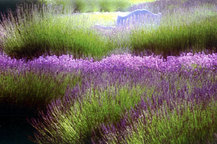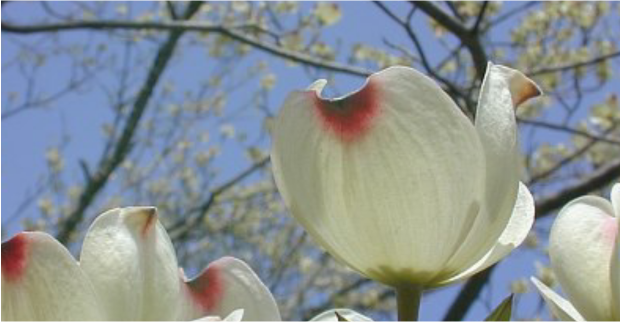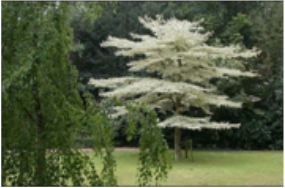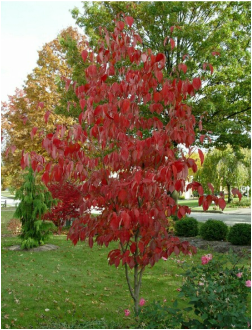|
There is a reason why I call Aunt Judy my twin! I had no idea that she was drawn to mountain excursions and the dogwood trees as much as me. If you've known me very long, you know that my husband Brian and I love to escape to the mountains. It doesn't matter what time of the year! Chasin' snow during winter or chasin' beautiful colors during spring or fall. In March of 2012, we escaped to my hometown Chattanooga, Tennessee for a much needed time of rest and soul care. There is a beautiful place we like to visit called Reflection Riding. It's hard to believe that it has been 4 years since we last visited there. The grounds are perfect for any artist or creative to get inspired! Or...if creativity isn't your thing, it's a great place to rest the mind and soul! You are free to park your car and walk where you'd like, but I recommend driving (thus, the name of the place) and stopping whenever you want to absorb the beauty of God's wonderful world. This little slide show is of the beautiful grounds...God's handiwork! We took these pics on our last visit. Please welcome Judy Ingle, our guest writer today. But before she shares with you her experience of the Dogwoods, prepare your heart with a little nature soul care and place yourself in her setting. I know you will be blessed! As I read and formatted her blog, I could smell the earth, hear the sounds and see the beauty of her travels. ~ Sherry April unfolded so graciously with her beauty and sweet smells of lilac and wild honeysuckle while we once again experienced God's rhythm of nature. We sensed His presence all around. It was our anniversary week and we both were feeling the buoyancy of spring and God's blessings as He scattered them along our paths. We have reveled in the wonder of His creation as the wisteria opened with it's beautiful cascades of violet sending forth the fragrance of spring-time. We watched the graceful butterfly in flight and it was so easy to become immersed in the sounds of the season sweetly luring us to the out-of-doors. I love the wisdom of Charles H. Spurgeon: "It is not how much we have, but how much we enjoy, that makes happiness."  We celebrated our 42nd wedding anniversary with a trip to the Smokey Mountains. We considered other places but we were ready for rest and renewal so this was right for us. Every year, with few exceptions, Jimmy plans a trip in mid-April to "chase the snow;" oops, "chase the Dogwoods." This has been a love of ours for a very long time. We just drive and delight in God's gorgeous landscapes while the magnetism of the mountains pull us like invisible magnets. This time we decided to take a closer look at the Dogwood Tree in all of it's splendor. I will try to share our pleasant journey and do hope you will experience some of our joy while finding, as we did, the spiritual connection and significance of "the aristocrat of all native flowering trees," the Dogwood. It is not unusual to experience a "Dogwood winter." This is simply a short "cold snap" during the early blooming season. We were met with chilly temperatures but quickly the temperature began to rise. Thinking warm was here to stay along came what some call a "Blackberry winter" meaning more cool weather. It has been told that this cool weather is necessary to set the blooms on the Blackberry vines. Finally, we were relishing in Spring's explosion of color and pleasant temperatures. As we traveled we were overwhelmed with trees of white, their branches reaching outward toward us as if to be calling our name on this our special day. Left and right the hills were graced with the delicate white petals of the Dogwood Trees. Taller and much more robust trees were barely budding yet this magnificent beauty was in full bloom showcasing itself in a most humble yet pronounced way and was certainly making it's presence known. The profusion of white set my thoughts into motion prodding me to explore this amazing tree that is so universally loved. "As a countenance is made beautiful by the soul's shining through it, so the world is beautiful by the shining through it of God." Frederick H. Jacoli As we continued to drive, the majestic mountains loomed in the distance. Soon we were close enough to smell the fragrance of the sap rising in the trees as they towered over us. The road began to wind and twist and the crooked streams and whooshing sounds of the water prompted us to lower our windows to hear the sounds and smell the earthiness. We had to pause and deeply inhale the pure clear smell of the mountainous air. Large boulders, some covered with moss, seem to give the meandering streams a song and we were compelled to stop and listen. We made the right choice, the mountains seemed a powerful solace. Samuel Taylor Coleridge once said, "Earth, with her thousand voices praises God." We found this so true. The Dogwood Tree seemed to be clinging to the edge of the banks while the angel-white boughs were bent towards the water that glistened in the sunlight. The simpering breeze now carried the smell of perfume along with a mulchy dampness that was so expected in the air. Huge trees, their branches gnarled with age stood stately still, although their foliage was not yet thick and lush. Huge roots sprawled like giant claws reaching for the water below reminding me of this verse: "And he shall be like a tree planted by the rivers of water, that bringeth forth his fruit in his season; his leaf also shall not wither, and whatsoever he doeth will prosper." Psalm 1:3 The trout-filled water was now awe-inspiring as the crystal, rushing streams effortlessly flowed along our road. The melody of the flowing and cascading water was also an elixir for our souls. The Dogwood tree was still the "show-stopper" with it's outstretched branches faithfully adorned in white just in time for Easter. This was the beginning of our journey into the study of my most beloved tree. I remember a poem that is popular at Easter- time called, The Legend of the Dogwood:
I believe this poet had a special insight concerning this unique and amazing tree. It does not normally grow large in height but is seen in forests and mountains growing underneath the larger trees. For this reason they are called "understory" trees. However, this tree also must have light and water. How does a smaller, understory tree, nestled and canopied by huge mountainous trees receive enough light to sustain life and produce magnificent blooms? The answer is fascinating. About two weeks before the leafing out of every other tree in the mountains, the graceful Dogwood displays its array of blooms. Thousands of larger trees surrounding them are only beginning to form their buds. During this two week window Dogwoods are clearly visible and unimpeded. The light and sunlight required is given to them allowing for photosynthesis, when water and carbon dioxide are converted to starches and used for food, a needful process for survival throughout the year. Our Heavenly Father perfectly times the blooming of this amazing tree just ahead of many hundreds of varieties of trees. Without the energy of the Sun during these two weeks there would be no photosynthesis. I find a similarity for us, in the same way we must receive "the Light" or we are unable to allow Christ to initiate the process of a loving relationship with us that is needed to sustain our lives for now and eternity. His light, His living water, and His word converts the soul of man giving salvation and new life. When we receive His Light we become a new creation illuminating His radiance. When plants and trees are in the presence of light, the sunlight is absorbed by chlorophyll in the leaves. Likewise, in the presence of God's Light He provides "Sonlight" for us to absorb daily helping us to grow closer to Him through the necessities of prayer, Bible reading and studying, and communication plus we have a personal relationship with Him. Therefore, His Light gives us the energy we need to serve Him and live for Him while life itself is sustained through Him. As I describe this majestic ornamental, it is noteworthy to recognize all the spiritual symbolism involved. The remarkable petals of white are probably most familiar as they were to me. However, the bloom is actually the round yellow centers called flower-heads. This round yellow center is surrounded by the delicate white petals which we call blooms. There are two long and two short petals forming the shape of a cross. Every petal has an obvious notch or indent on it's end. The notch is stained with a reddish-brown color which so symbolizes Christ's shed blood during His crucifixion. The round yellow center is referred to as "the crown of thorns." It is documented that this yellow center produces 22 very small blooms. We actually counted the center blooms on 3 different Dogwood trees and found this to be true. The significance? Psalm 22:1 says, "My God, My God, Why hast thou forsaken me?" Reading this information my heart was touched and I began to weep. This new information also caused my excitement to rise like that of a launching rocket. With great anticipation and teary eyes I wanted to learn more so I searched and this is what I found. This tree is the first tree to change colors in the fall. The leaves turn "scarlet" or crimson to burgundy-red enhancing their environment with elegance. Soon after the leaves are dropped, it bears bright-red fruit. The fruit lasts from fall through the winter months when they become the all-u-can-eat buffet of robins, mockingbirds and other birds and wildlife. Deer love the delicious Dogwoods. They find the tasty flowers and leaves a delight. Interestingly, Dr. John Piper writes: Before we met Christ we were dead, blind, deaf and insensitive to God's glory; We couldn't taste it as beautiful...Conversion to Christ puts within us a taste for divine things, a taste for the glory of God. Our battle is to constantly see Him more clearly that we might delight in Him more fully." Also, Psalm 34:8 tells us so well, "O taste and see that the Lord is good: blessed is the man that trusteth in Him." Spring is welcomed by the beautiful burst of white. The flowers provide nectar and pollen for the bees, being a great provision while the horizontal branches provide nests for the sparrow. God's plan is always sufficient and good for all. As the branches stretch and hover in an unusual and identifiable manner it reminds me of the lyrics of a song I used to sing: "The ground is level at the foot of the cross, no man stands higher than I. I can call on Jesus name and a king can do the same, the ground is level at the foot of the cross." Spotting these trees is easy because of their flat, umbrella like shape.  So far all elements of the tree described provide beauty and benefit. Also notice how much "crimson" describes the tree. We studied the bark and the trunk of the tree finding the amazing bark to be rich in tannins, a "bitter" reddish acid that is ground and used in tanning leather products, making ink, and dying fabric. Also, the tannins in the bark are important for providing protection from predators and pests. The astringent properties of tannin is also used in medicine to relieve pain, fever and etc. Jesus, our great physician, said in Luke 5:31: They that are whole need not a physician; but they that are sick.  The grain of the bark itself is interlocked with a very fine but dense texture. Because of its's hardness and smoothness and it's ability to shine and resist shock, it has been used for golf-club heads, the finest weaving shuttles, mallets, archery bows and wooden wheels. Therefore, known to be one of the hardest woods. This outstanding, graceful tree is profitable to mankind along with it's four-season beauty. Moving down to the root system I am still intrigued. The tap root, the life of any tree, branches out in the same manner as the upper branches. Normally a tree's tap root basically grows straight down with secondary roots branching out. The Dogwood's tap root branches out and is always reaching outward and stretching into the dirt and murky earth acting as an anchor of strength. Similarly, Christ is reaching with outstretched arms pulling us from the miry clay. Psalm 40:2 says: "He brought me up also out of an horrible pit, out of the miry clay and set my feet upon a rock, and established my goings." Finally, it is amazing to note that the extracts from the root of this tree were used to make a "scarlet dye." This final fact pricked my heart once again and I believe I understand more fully why this tree has always been so dear to my heart and why in Spring we drive any distance to revel in it's beauty and relevance. This stupendous tree serves as a provision, protection and is profitable. Just as Christ is our provision, our protection in all things and is profitable to us in all things. Every element, including it's unique growth pattern seems to proclaim the story of the love of God. The "Legend of the Dogwood" may only be a legend but the tree definitely bears a spiritual significance that cannot be denied. Throughout every season of the year the tree is a reminder of "Whatsoever things are true, whatsoever things are honest, whatsoever things are just, whatsoever things are pure, whatsoever thing are lovely, and whatsoever things are of good report; if there be any virtue and if there be any praise, think on these things (Phillipians 4:8)." May we be awakened this Spring to God's true splendor and train our thoughts to desire an attitude and spirit of love as we interact with others to proclaim Christ as Lord of all. As the Dogwood tree stands as a witness for Him, may we ever raise our voice of praise and sacrifice our lives to the glorious Creator and Saviour of the world. Praise the Lord, Praise the Lord, Praise the Lord! Marveled at His wonderful work, Judy Ingle  Be sure to join us each week for Monday Musings. Feel free to share on your social media. Join our email subscription to receive the blog automatically each week in your email. Sign up at the top right of this post.
0 Comments
Leave a Reply. |
Sign Up to Receive our Blog via email.
Click to set custom HTML
Archives
July 2021
Categories |









 RSS Feed
RSS Feed

